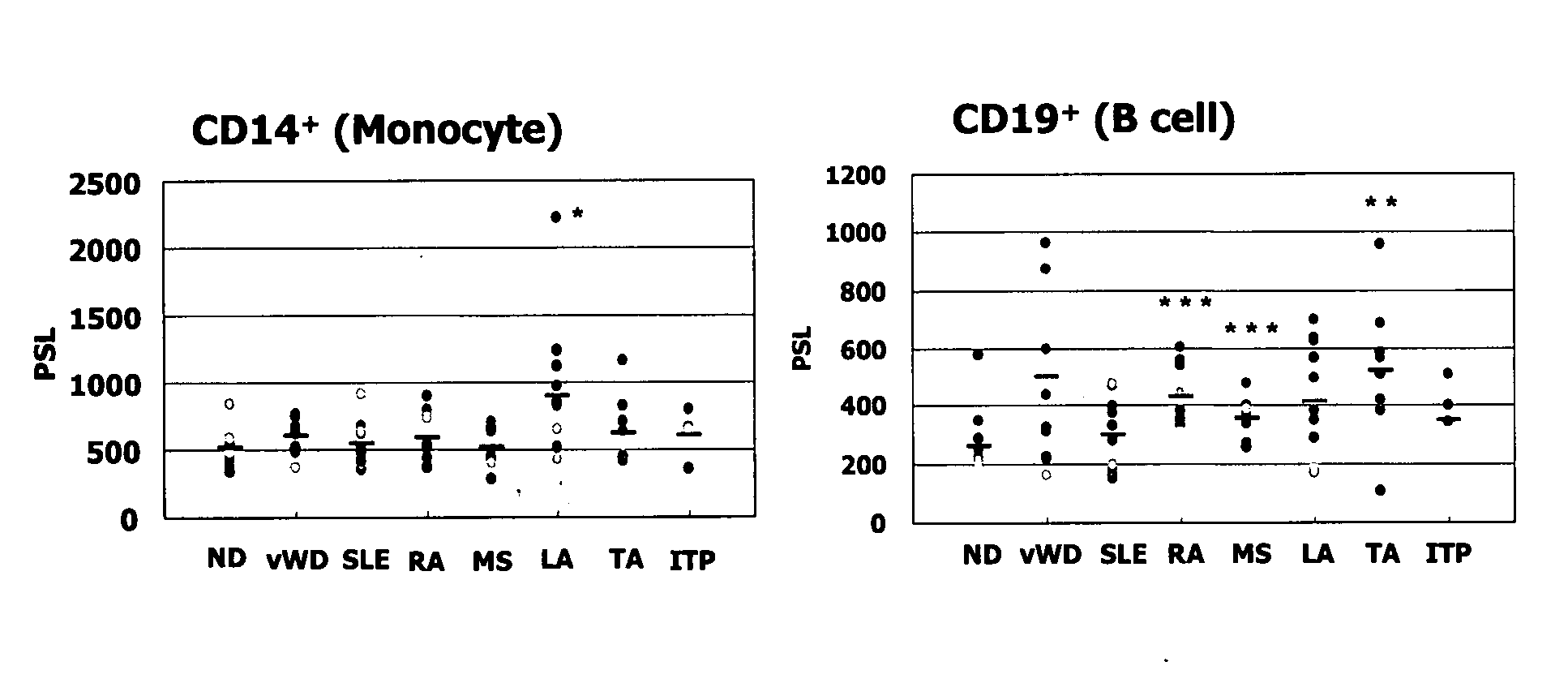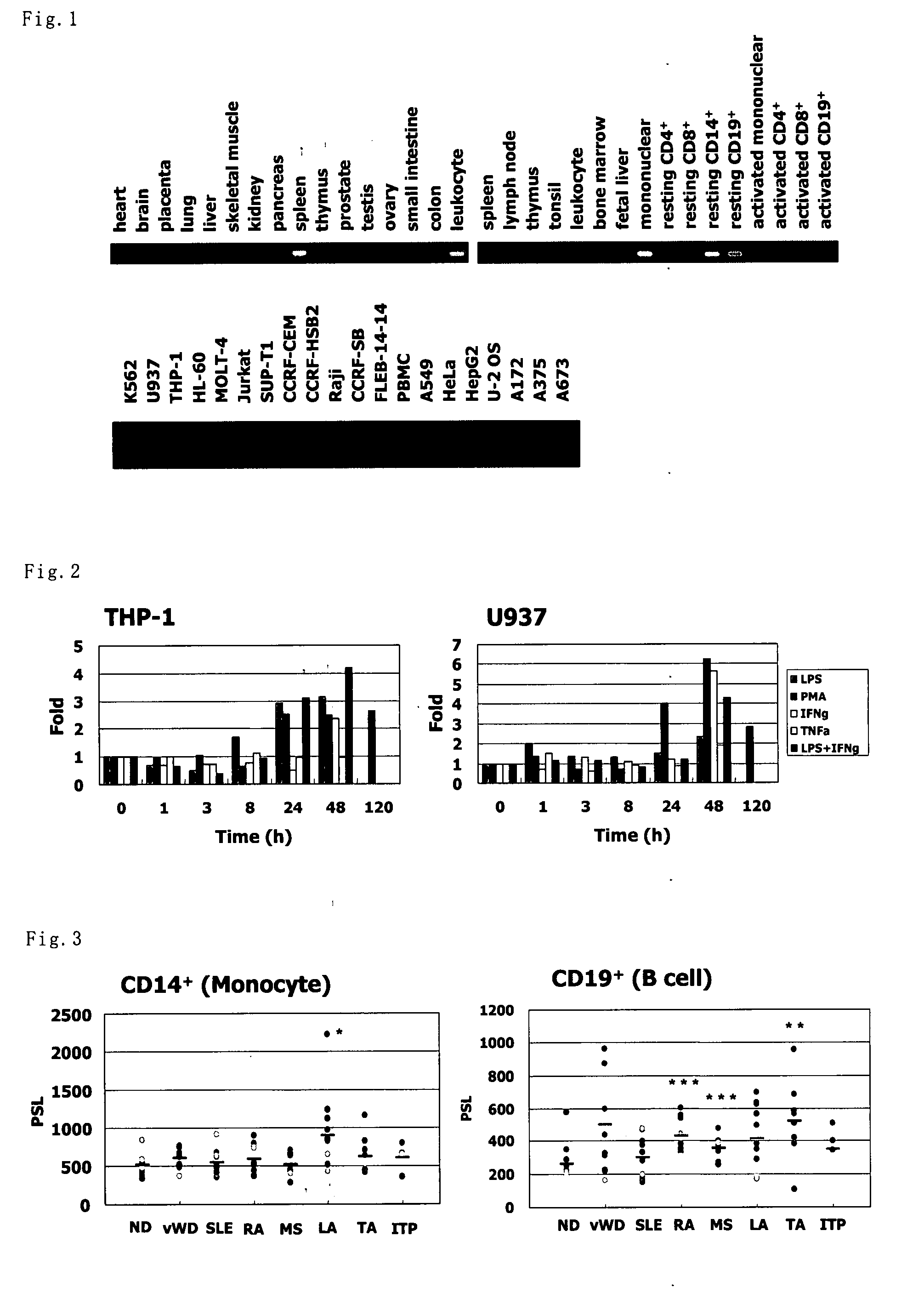Use of immunesuppressant receptor
a technology of immunosuppressive receptor and antagonist, which is applied in the field of immunosuppressive receptor antagonist, can solve the problems that the functions of the protein related to the present invention are not sufficiently elucidated, and the use of antagonists and agonists thereof is not known at all
- Summary
- Abstract
- Description
- Claims
- Application Information
AI Technical Summary
Benefits of technology
Problems solved by technology
Method used
Image
Examples
example 1
Expression Profile Of Human BIR1
[0219]In order to examine expression of BIR1 mRNA in human normal tissues, blood cells and cell strains, BIR1-specific primers were designed, and PCR was carried out using TaKaRa Ex Taq (manufactured by TaKaRa). Sequences of the primers used therein are shown below.
5′-GAACAGGCTCCTCTTCTGGAG-3′(SEQ ID NO:13)5′-GGTTCACCTTTTCCATCCTGG-3′(SEQ ID NO:14)
[0220]The PCR was carried out by firstly keeping at 96° C. for 1 minute, subsequently repeating 35 cycles of a temperature operation of 98° C. for 10 seconds, 56° C. for 30 seconds and 72° C. for 30 seconds, and finally keeping at 72° C. for 10 minutes.
[0221]Human MTC Panel I, Human MTC Panel II, Human Immune System MTC Panel and Human Blood Fractions MTC Panel (manufactured by BD Clontech) were used in the expression analysis of human normal tissues and blood cells, and cDNA prepared from total RNA by reverse transcription reaction in accordance with the usual way was used in the expression analysis of human ...
example 2
Expression of Human BIR1 by Various Inflammation Stimuli
[0223]Expression of BIR1 by various inflammation stimuli was examined using human monocyte system cell strains. At a density of 1×106 cells / 2 mL, each of THP-1 cells and U937 cells were stimulated with lipopolysaccharide (LPS) (1 μg / mL), phorbol myristate acetate (PMA) (100 ng / mL), IFN-γ (100 ng / mL), TNF-α (10 ng / mL) or LPS+IFN-γ (1 μg / mL+100 ng / mL), for 1, 3, 8, 24, 48 or 120 hours, and the total RNA was recovered. Amount of RNA of BIR1 was determined by ABI PRISM 7000 Sequence Detection System (manufactured by Applied Biosystems) using BIR1-specific primers; 5′-CACAGCCATGGAAGTTGGAATC-3′ (SEQ ID NO:15) and 5′-GAGTGTTTGGCCTCATCTTGG-3′ (SEQ ID NO:16) and QuantiTect SYBR Green RT-PCR Kit (manufactured by QIAGEN). The PCR was carried out by firstly keeping at 50° C. for 30 minutes and then at 95° C. for 15 minutes. Next, a temperature operation of 94° C. for 10 seconds, 56° C. for 30 seconds and 72° C. for 1 minute was repeated 45...
example 3
Expression of BIR1 in Autoimmune Disease Patient-Derived Blood Cells
[0224]Expression of BIR1 in autoimmune disease patient-derived various blood cells were detected using Autoimmune Disease Profiling Array (manufactured by BD Clontech). A BIR1-specific probe labeled with [α-32P] dCTP (manufactured by Perkin Elmer) was prepared using Random Primer DNA Labeling Kit Ver. 2 (manufactured by TaKaRa), using a human BIR1 partial length cDNA fragment as the template. The partial length cDNA fragment used therein is shown in SEQ ID NO:17.
[0225]The pre-hybridization, hybridization and washing operations after the probe preparation were carried out in accordance with the instructions attached thereto. By obtaining image data using BAS 2000 (manufactured by FUJIFILM), PSL (photo-stimulated luminescence; proportional to radiation dose) value of each dot was calculated from the image data using the Image Analyzer II of BAStation Ver. 2.21, and the expressed amount of BIR1 in each sample was numer...
PUM
| Property | Measurement | Unit |
|---|---|---|
| temperature | aaaaa | aaaaa |
| temperature | aaaaa | aaaaa |
| temperature | aaaaa | aaaaa |
Abstract
Description
Claims
Application Information
 Login to View More
Login to View More - R&D
- Intellectual Property
- Life Sciences
- Materials
- Tech Scout
- Unparalleled Data Quality
- Higher Quality Content
- 60% Fewer Hallucinations
Browse by: Latest US Patents, China's latest patents, Technical Efficacy Thesaurus, Application Domain, Technology Topic, Popular Technical Reports.
© 2025 PatSnap. All rights reserved.Legal|Privacy policy|Modern Slavery Act Transparency Statement|Sitemap|About US| Contact US: help@patsnap.com



